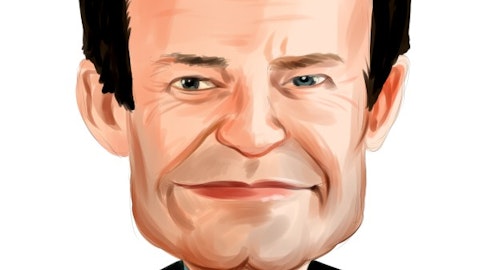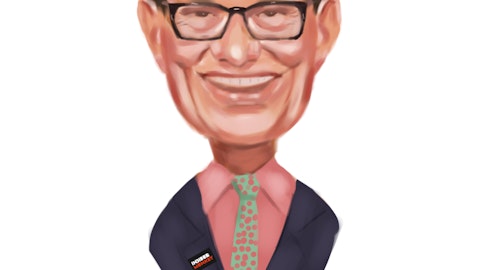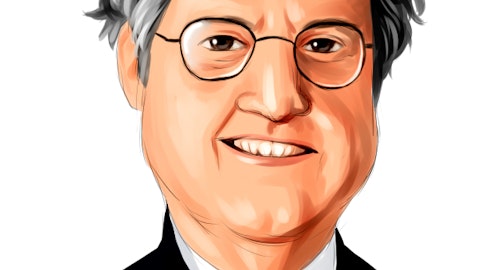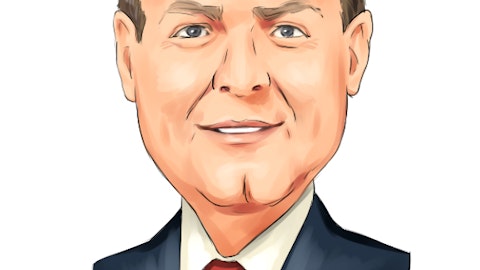Greenhill & Co., Inc. (NYSE:GHL) Q4 2022 Earnings Call Transcript February 1, 2023
Operator: Good day, everyone, and welcome to the Greenhill Fourth Quarter and Full Year 2022 Earnings Conference Call. . Please also note, today’s event is being recorded. At this time, I’d like to turn the floor over to Patrick Suehnholz. Sir, please go ahead.
Patrick Suehnholz: Thank you. Good afternoon, and thank you all for joining us today for Greenhill’s Fourth Quarter 2022 Financial Results Conference Call. I am Patrick Suehnholz, Greenhill’s Head of Investor Relations. And joining me on the call today is Scott Bok, our Chairman and Chief Executive Officer. Today’s call may include forward-looking statements. These statements are based on our current expectations regarding future events that, by their nature, are outside of the firm’s control and are subject to known and unknown risks, uncertainties and assumptions. The firm’s actual results and financial condition may differ possibly materially from what is indicated in those forward-looking statements. For a discussion of some of the risks and factors that could affect the firm’s future results, please see our filings with the Securities and Exchange Commission, including our annual report on Form 10-K, quarterly reports on Form 10-Q and current reports on Form 8-K.
Neither we nor any other person assumes responsibility for the accuracy or completeness of any of these forward-looking statements. You should not rely upon forward-looking statements as predictions of future events. We are under no duty to update any of these forward-looking statements after the date on which they are made. I would now like to turn the call over to Scott Bok.
Scott Bok: Thank you, Patrick. Our revenue was $95.8 million for the fourth quarter and $258.5 million for the year, and our earnings per share was $0.95 for the quarter and $0.15 for the year. Consistent with my commentary on the last couple of quarterly calls, our largest fees for 2022, all landed late in the year, and as a result, our second half revenue was more than double that of our first half. Yet our revenue outcome fell short of our even higher expectations as the slower pace of deal completions meant many more transaction processes carried over to the New Year than we expected. In recent years, we’ve seen particularly strong transaction completions in our fourth quarters, such that our backlog was somewhat depleted at the start of the next year, resulting in a weak first half revenue.
Between the projects we carried into 2023, expectations for an improving operating environment as interest rate hikes wind down and the likelihood of improved advisory activity and restructuring as well as M&A, we expect a considerably stronger first half than we’ve seen in the last few years as well as a return to higher revenue and more typical profit margins for the full year ahead. Clearly, the market environment today remains challenging, but our predominantly public company client base remains ready, willing, and able to pursue strategic opportunities. And we are less reliant than many of our peers on financial sponsors, technology sector or other areas that have been most impacted by recent market conditions. With respect to where our 2022 revenue came from, the key sectors were industrial and telecom infrastructure.

Photo by Dimitri Karastelev on Unsplash
Those sectors should remain active, and we expect to see increased activity in energy, health care, mining and other sectors in the year ahead. We saw good diversity of 2022 revenue in a geographic sense with Canada, France and Spain, all important contributors. Australia made a solid contribution and carried a strong backlog into the New Year. It is worth noting that our 2022 revenue was negatively impacted by the fact that non-dollar currencies have been unusually weak, particularly in the second half of the year when many of our larger overseas fees were booked. Already, there has been a meaningful recovery in those currencies. And if the dollar declines further, we will further benefit as overseas fees translate into more dollar revenue.
By type of advice, we saw less financing and restructuring work in 2022, but expect both those areas to be more active in the year ahead given relatively weak economic conditions and challenging credit markets. In our private capital advisory business, we’ve been in building mode the last couple of years, but we entered 2023 with an attractive backlog of primary fundraising assignments and our secondary transaction business has remained active globally. We continue to focus on our key strategic initiative of expanding our coverage of financial sponsors to supplement our historic public company client base. Sponsors are able to use every service we provide from M&A to financing, restructuring and fund raising. And expanding our financing advisory business, principally to help sponsors as well as other clients access the direct lending market remains a key objective as well.
Across our businesses, we are aiming for 2023 to be a significant recruiting year. We announced one new managing director recruit today, and we are in dialogue with many interesting potential recruits principally in the U.S. market across key sectors where we want to expand. We also continue to develop our own talent as evidenced by the 4 Managing Director promotions referenced in our press release. Turning to our costs. Our compensation expense for the quarter was $44.4 — $44.5 million and for the year-to-date was $179.8 million. The quarterly and annual figures were both lower than last year in absolute terms, but the resulting compensation ratio was higher than normal given our revenue outcome. An important objective for 2023 is to bring our compensation ratio back down to our target range.
Our non-compensation costs were $18.3 million for the quarter and $58.1 million for the year, a bit higher than last year, given a loss on foreign currency movements, a somewhat unusual professional fee paid to a co-adviser, increased travel expenses and carrying 2 London leases while we built out some new space there. Looking ahead to 2023, we should not incur the kind of duplicative rent we have had in the last few years as we built out new locations for our 2 largest offices. We likewise do not expect to see the other various unusual items again. Our balance sheet at year-end remained in good shape with $104.3 million in cash. Our term loan balance remains at $271.9 million. Our loan matures in April 2024 and so we will look to optimize the timing of refinancing in coming months.
In the next quarter or 2, we expect the trailing 4 quarter metrics that the credit markets focus on will have moved to a much improved place, and we are hopeful that credit market conditions will have continued to evolve to a more favorable place by then too so that we can achieve highly attractive terms just as we did in our 2 prior financings. We expect to deleverage significantly over the next few years, starting in 2023 given that the cost of our dividend is modest, and the liquidity of our stock is such a potential for further significant share repurchases is limited. During the fourth quarter, we repurchased a little over 1 million shares and share equivalents for a cost of about $9.5 million. And for the year, we repurchased almost 3 million shares for a cost of about $40 million.
For 2023 through next January, our Board authorized the repurchase of an additional $30 million of stock and stock equivalents, which should be largely sufficient to offset equity grants to employees. Our Board also declared a quarterly dividend of $0.10 per share, consistent with recent quarters. This is a good place to note that in our press release, we speak of a transition in our CFO position. Harold Rodriguez will, after more than 20 years with us, shortly moved to a part-time advisory position as he prepares for retirement. And Mark Lasky will step into his CFO role. Mark has been with us for 10 years. And before that, spent 12 years in finance roles at Goldman Sachs, so he is well prepared for this role and Harold will continue to be around to help as needed.
I will close with a brief note that our stock performance in 2022 was heavily impacted by the fact that by a very narrow margin in the spring, we slipped out of the primary small cap indexes. Based on our current market capitalization and the current metrics for those indexes, we are on track to be readmitted in 2023 and a strong start to this year would obviously make that even more likely. With that, I’m happy to take any questions.
See also 10 Cheap Lithium Stocks To Buy and 15 Largest Ophtalmology Companies in the World .
Q&A Session
Follow Greenhill & Co Inc (NYSE:GHL)
Follow Greenhill & Co Inc (NYSE:GHL)
Receive real-time insider trading and news alerts
Operator: . Our first question today comes from Devin Ryan from JMP Securities.
Devin Ryan: Maybe starting on, Scott, your comments just for an expectation for improving operating backdrop for 2023. I guess what are you seeing in the environment? Or any signs that maybe can you feel a bit better about how this year starting relative to 2022? I appreciate you coming into the year with a better backlog. But what you’re seeing to make you feel better just around the tone of activity? And then if you can just weave in a little bit of kind of geographic perspective around that would be helpful.
Scott Bok: Sure. Good questions. Look, I put it this way. We felt like we were quite busy in the latter half of last year. The only kind of constraint, we felt like we had against us was things just sort of taking longer to get done than perhaps they normally do. So there’s not a feeling that any of the things we perhaps thought at one point we’re going to close in December have died. It’s really just things are taking a bit longer to get done. So that’s an encouraging sign. Look, I’d also say that, whereas a year ago, I think everybody was incredibly optimistic, right? That was before the Ukraine invasion and higher inflation and interest rates and all the rest. If you look at where we are now, we’re kind of at probably very recently a sort of peak pessimism in some senses in the market.
But clearly, rates are now starting to come down on the long end, inflation starting to come down. And the companies we talk to, look, they’re going to still be cautious. They know that it’s going to be a challenging operating environment for them in their own businesses through 2023, but I feel like people can now see to the other side, they can see a peaking in the Fed’s interest rate hikes. And I think there’s an increasing sense that to the extent there’s a recession, it’s not going to be a long run or a deep one. So frankly, I think it could turn out to be, in some ways, the opposite of last year. I mean, last year, the market was very, very optimistic in January. That turned out to be a very difficult year. This year, the market was probably very, very pessimistic in January, and it could be the year of a bounce back.
Devin Ryan: Great. Just on capital return and deployment. So I appreciate kind of the focus this year is more on debt paydown. I think that makes sense. But you still have a relatively large repurchase authorization. So I guess, like is there any way to add some context around the ability to return capital through buybacks and maybe what would shift that interest maybe more towards buybacks? Is it just a lower stock price? Or are you pretty set on the debt paydown?
Scott Bok: I think where we are — really the focus on — the refocus kind of on debt pay down is more a function of constraints on buying back shares than it is on the desire to buy back shares. So as you all know, there are trading volume limitations on how any company can buy back shares, and we frankly bought back so many that we’re now finding there’s a pretty limited amount left that we can buy at any given time. So when we throw out as the new authorization for kind of the next 12 months, of $30 million. We think that’s going to be not only about offset any shares that are vesting for employees. But at least it’s important. We think that’s about all we’d be able to do anyway. So what we’re saying is a dividend in absolute dollar cost is quite modest.





